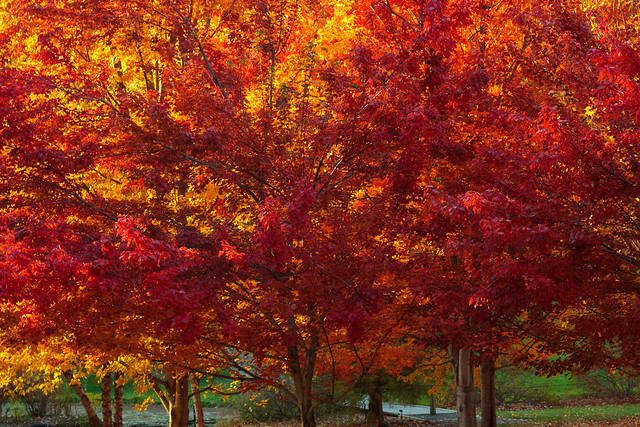I’ve been spending a lot of time finishing up my dissertation proposal, which is due in a little over a week, and that has kept me from taking time to enjoy the outdoors. We got some considerable rain over the past weekend which lead to some dramatic skies and really clear views on Monday and Tuesday, but I just wasn’t able to take advantage of the nice conditions. I did get out for a little bit yesterday afternoon to check out the fall foliage in the arboretum on campus.
In Idaho, we don’t see very much fall color. There are a few shrubs and trees that turn this time of year, but for the most part, the grasses become even more brown, and most of the deciduous plants skip the color part altogether. The key to great color is a cold and wet climate. We have the cold during the winter, and even the wet in the spring and early summer, but it gets too hot and dry to sustain wild populations of maples, birches, and aspen. What we get are some stands of colorful trees here and there rather than large vasts of colorful forests that carpet the landscapes of Maine, New Hampshire, and Vermont. But there are some places where these trees have been planted and maintained in an artificial setting. The university’s campus is one place to find such color.
You won’t find much color out of the giant Norway Maples on the front lawn, but the Sugar Maples, Black Maples, and Red Maples along with a few other species produce spectacular displays. Some of the best fall trees are located right behind the life science building, but another great stand is found in the arboretum. These trees, native to northeastern North America, are sustained by constant watering and landscape maintenance throughout the dry summer. It’s the best we can do in this part of the country to reproduce the kind of fall seen in northern New England and southern Canada.
The fall colors that we know and love are a result of pigments produced by the plants year round. But during the growing season, they are masked by the abundance of chlorophyll produced. As a result, these pigments aren’t seen during the spring and summer. But as the season comes to and end and temperatures drop, the plant stops producing pigments for photosynthesis. The chlorophylls are the first to break down, and when they do, we are left with the xanthophylls and carotenoids which are yellow and red. These pigments aid the plant in photosynthesis by absorbing wavelengths missed by the chlorophylls. Each species has a different compositional make-up of pigments such that when the chlorophyll breaks down, we see different colors in each plant.
Click on the image above to see some more images from my walk in the arboretum.

